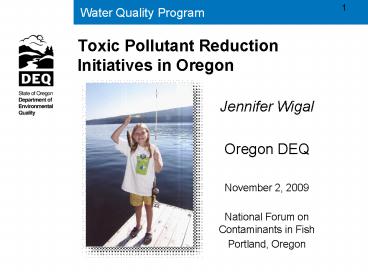Toxic Pollutant Reduction Initiatives in Oregon - PowerPoint PPT Presentation
1 / 13
Title:
Toxic Pollutant Reduction Initiatives in Oregon
Description:
Revising water quality standards targeted at human health protection ... Discussion and action on pollutants that have not been given much thought ... – PowerPoint PPT presentation
Number of Views:40
Avg rating:3.0/5.0
Title: Toxic Pollutant Reduction Initiatives in Oregon
1
Toxic Pollutant Reduction Initiatives in Oregon
- Jennifer Wigal
- Oregon DEQ
- November 2, 2009
- National Forum on Contaminants in Fish
- Portland, Oregon
2
- What do fish advisories have to do with water
quality standards?
3
State Agency Programs Addressing Toxics in Fish
System
Intervention Strategy
Agency Activities
Upstream Prevention
Water Quality Standards Development and
Implementation Toxics Monitoring (water, fish
tissue) Priority Persistent Pollutants (SB 737)
Prevention-based toxics reductions
Behavioral-based interventions to prevent
exposures to toxics
Fish Consumption Advisory Program (outreach
provided in part by ODFW Oregon Sport Fishing
Regulations)
Downstream Reactive
4
Oregons Water Quality Standards
- Revising water quality standards targeted at
human health protection - New fish consumption rate 175 g/day
- Based on local and regional data
- Standards derived to protect people who eat fish
and shellfish - Will be highest fish consumption rate of any
state (and consequently, the most stringent
values)
5
Our Approach
- Partnerships
- Confederated Tribes of the Umatilla Reservation
- EPA
- Stakeholders
- Advisory Committees
- Members include Environmental Organizations,
Municipal WWTPs, Tribes, Industry - Internal Coordination
- Connecting with other programs targeting toxic
pollutants
6
WQS Revisions Will Not Solve All Toxics Problems
- Implementing WQS with a focus on traditional
sources in traditional ways will not result in
removal of the most important toxics from the
environment - WQS pollutants do not represent all of the toxic
pollutants of concern
7
Where Were Headed
- Oregons Environmental Quality Commission
directed DEQ to approach toxics reduction broadly - Discussions focused not only on criteria
recalculations, but also - Cost-effective, environmentally meaningful
standards implementation - NPDES permitted sources augmenting end-of-pipe
treatment with other actions (e.g., source
reduction) - Other sources of toxic pollutants
- Connections to other toxics reduction efforts
8
- WQS part of reducing and preventing risks
- Complementary to other programs in addressing
contaminants of concern
9
Related Activity Priority Persistent Pollutants
(Senate Bill 737)
10
SB737 What is it?
- Concerned with toxic pollutants in Oregons
waters - State StatuteNot related to federal statutes or
requirements - Focus Toxics Reduction
- List development for priority persistent
pollutants first of its kind
11
Priority Persistent Pollutants (SB737)
- Statute requires DEQ to
- Develop a list of priority persistent
bioaccumulative toxics (Final List October 2009). - Report to the Legislature on all sources of
priority persistent pollutants and identify
opportunities for source reduction by June 2010. - Requires Oregons 52 large municipal wastewater
treatment plants to - Develop toxics reduction plans by July 2011 for
pollutants in effluent above trigger levels.
12
Developing the Priority Persistent Pollutant (P³)
List
- Identify chemicals that meet defined
characteristics - Toxicity and either
- Persistence or
- Bioaccumulation
- DEQ will look to confirm presence in sediment,
water or fish tissue and/or likelihood of
presence in Oregon waters - P3 List incorporates some information
- Efforts on source identification will result in
additional information (Report due June 2010)
13
What will happen as a result?
- Discussion and action on pollutants that have not
been given much thought - Awareness and actions not just among
municipalities, but also the general public - Integration among other toxics reduction efforts































